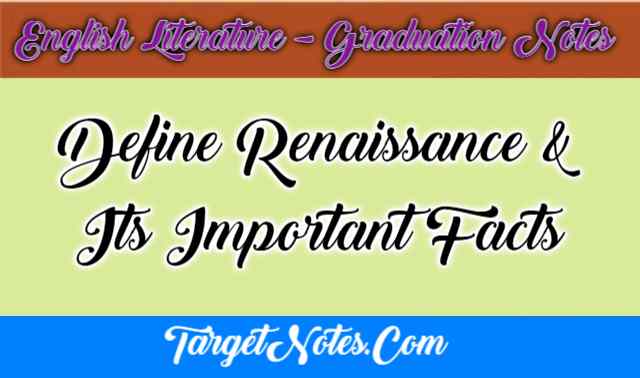
Contents
Renaissance & Its Important Facts
A Brief Introduction
The word ‘Renaissance‘ means ‘Rebirth’ or ‘Reawakening’.
The term ‘Renaissance’ means the ‘Revival of Learning’. The term Renaissance “Men of Renaissance were like those captives who have been kept in dark dungeons and gradually returned to all the loveliness and luxuries of life.”
The Renaissance period in English Literature is also known as The Elizabethan Age’ or ‘The Age of Shakespeare’. The Renaissance began in Italy in the fourteenth century and in the fifteenth and the sixteenth century it spread over Western Europe and England. The Renaissance came to England with the first of the Tudor Kings, Henry VII and in the next century spread its influence over all aspects of culture scholarship, literature, science, art, architecture and music..
Important Facts to Remember
1. The chief characteristic of the Renaissance was its emphasis on Humanism. Humanism means Man’s concern with himself as an object of contemplation came to be known as Humanism. It was “man discovery of himself.”
2. Erasmu’s “Praise of Folly” and “Sir Thomas More’s Utopia” (1516) in Latin were remarkable works of Renaissance.
3. The Sonnet was orginally produced in the hands of Petrarch, the Italian Poet of fourteenth century called Petrarchan Sonnet or Italian Sonnet.
4. Petrach and Boccacio were among the earliest of the humanists and their work marks the dawn of the Renaissance.
5. In Renaissance, the famous collection of songs and sonnets by Wyatt and Surrey and some others, called after the name of its “Tottel’s miscellany.
6. Wycliff, Peacock and more are considered the first writer of English Prose.
7. Chaucer has rightly been called The Morning Star of Renaissance’.
8. The Hundred Year’s war with France and the defeat of the Spanish Armada brought about revival of nationalist and patriotic feelings among the Elizabethan.
9. The Spanish Tragedy (1589) of Thomas Kyd’s skillfully managed in Renaissance.
10. Malory’s Le Morte de Arthur was among the first works to be printed by William Caxton who introduced the Printing Press to England in 1476.
11. Christopher Marlowe’s great works of drama represent the Renaissance spirit. For example. Dr. Faustus, Tamburlaine, Jew of Malta and Edward II.
12. Similarly, Shakespeare dramas also represent the Renaissance spirit. His best comedies are As You Like It (1599), Twelfth Night (1600). And his great tragedies such as Hamlet (1601) Othello (1604), King Lear (1605), Macbeth (1606) and Antony and Cleopatra (1606).
13. Francis Bacon through his 58 essays prove his unsatiable thrust or hunger for knwoledge. When he says, “I want to take all knowledge to be my providence.”
14. Spensor’s poetry (Fairy Queen) was masterpiece work of the Renaissance. Spenser was called the “Child of Renaissance and Reformation”.
15. In literature the most famous productions were: In Politics Machiavelli’s, “The Prince”. In the field of Art and Sculpture it produced Raphael’. In Science and Engineering, Leonardo Da Vince’ who was a great engineer, poet, musician and thus a perfect gift of the versatile culture of the age. In literature, il gave us ‘Shakespeare’, ‘Marlowe’ in England, Aristotle’ in Italy.
Related Link
- Features of Developed Money Market | Recent developments in India’s money market
- Main Forms of Government Securities
- Instruments of Issue
- Difference between capital market and money market
- Role of SEBI in Regulating the Capital Market
- Functions of SEBI: Regulatory and Preventive Functions
- Advantages and Disadvantages of call money market
- Recent trends in the Indian capital market
- Characteristics of Indian Capital Market
- Globalisation and Indian Financial Market
IMPORTANT LINK
- What is the Exchange Rate System in India?
- Evolution of foreign exchange market in India
- Meaning and importance of export finance.
- Role of Export-Import Bank in Financing India’s Foreign Trade
- How Commercial banks Export Finance to Overseas Importers?
- Explain packing credit in detail?
- What is Post-shipment credit?
- What is Pre-shipment or packing credit?
- Explain Export Credit in India?
- Institutions Providing Finance and Credit Facility for Foreign Trade
- What is Risk Analysis?
- Explain Political risks in detail? and its Types
- What are the types of Risks. Explain in detail?
- Meaning and Types of commercial risks
- How can we minimize foreign trade risks?
- What are Arbitrage operations?
- Difference between Spot Market and Forward Market
- What is spot exchange?
- Agency agreement: Meaning, Features and Advantages
- Functions of Foreign Exchange markets
- structure of Foreign exchange markets
- Describe the various types of money
- Dynamic Functions of Money
- Evils or Demerits of Money
- Importance and significance of money in Modern Economy
- Approaches regarding Definitions of Money and its Function
- Money: Meaning, Definitions and features of Money
Disclaimer






